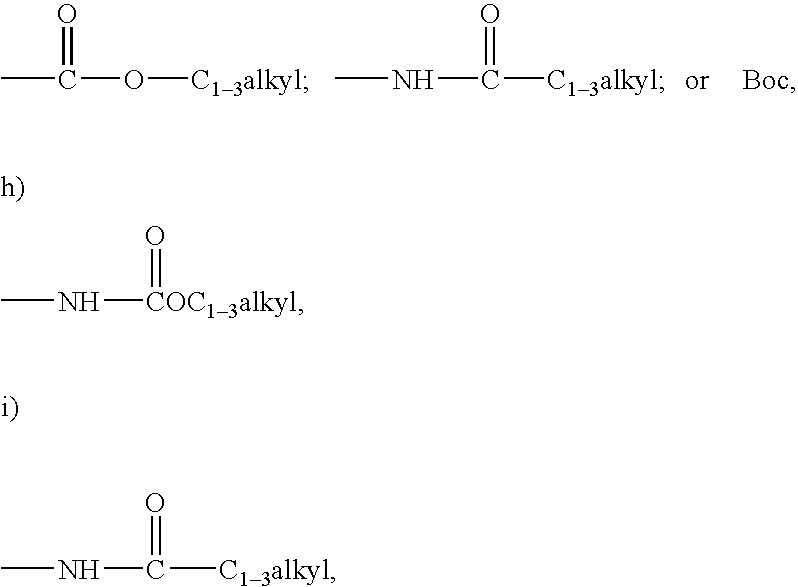Allylamides useful in the treatment of alzheimer's disease
a technology of alzheimer's disease and allylamide, which is applied in the direction of biocide, drug composition, peptide/protein ingredients, etc., can solve the problems of severe impairment and eventual death, and no effective treatment for halting, preventing, or reversing the progression of alzheimer's disease. , to achieve the effect o
- Summary
- Abstract
- Description
- Claims
- Application Information
AI Technical Summary
Benefits of technology
Problems solved by technology
Method used
Image
Examples
example a
The compounds of the invention are analyzed for inhibitory activity by use of the MBP-C125 assay. This assay determines the relative inhibition of beta-secretase cleavage of a model APP substrate, MBP-C125SW, by the compounds assayed as compared with an untreated control. A detailed description of the assay parameters can be found, for example, in U.S. Pat. No. 5,942,400. Briefly, the substrate is a fusion peptide formed of maltose binding protein (MBP) and the carboxy terminal 125 amino acids of APP-SW, the Swedish mutation. The beta-secretase enzyme is derived from human brain tissue as described in Sinha et al, 1999, Nature 40:537-540) or recombinantly produced as the full-length enzyme (amino acids 1-501), and can be prepared, for example, from 293 cells expressing the recombinant cDNA, as described in WO00 / 47618.
Inhibition of the enzyme is analyzed, for example, by immunoassay of the enzyme's cleavage products. One exemplary ELISA uses an anti-MBP ca...
example b
Cell Free Inhibition Assay Utilizing a Synthetic APP Substrate
A synthetic APP substrate that can be cleaved by beta-secretase and having N-terminal biotin and made fluorescent by the covalent attachment of Oregon green at the Cys residue is used to assay beta-secretase activity in the presence or absence of the inhibitory compounds of the invention. Useful substrates include the following:
Biotin-SEVNLDAEFRC[Oregon green]KK[SEQ ID NO: 1]Biotin-SEVKMDAEFRC[Oregon green]KK[SEQ ID NO: 2]Biotin-GLNIKTEEISEISYEVEFRC[Oregon green]KK[SEQ ID NO: 3]Biotin-ADRGLTTRPGSGLTNIKTEEISEVNLDAEFC[Oregon green]KK[SEQ ID NO: 4]Biotin-FVNQHLCoxGSHLVEALY-LVCoxGERGFFYTPKAC[Oregon green]KK[SEQ ID NO: 5]
The enzyme (0.1 nanomolar) and test compounds (0.001-100 micromolar) are incubated in pre-blocked, low affinity, black plates (384 well) at 37 degrees for 30 minutes. The reaction is initiated by addition of 150 millimolar substrate to a final volume of 30 microliter per well. The final assay conditions ...
example c
Beta-Secretase Inhibition: P26-P4′SW Assay
Synthetic substrates containing the beta-secretase cleavage site of APP are used to assay beta-secretase activity, using the methods described, for example, in published PCT application WO00 / 47618. The P26-P4′SW substrate is a peptide of the sequence:
[SEQ ID NO: 6](biotin)CGGADRGLTTRPGSGLTNIKTEEISEVNLDAEF
The P26-P1 standard has the sequence:
[SEQ ID NO: 7](biotin)CGGADRGLTTRPGSGLTNIKTEEISEVNL.
Briefly, the biotin-coupled synthetic substrates are incubated at a concentration of from about 0 to about 200 micromolar in this assay. When testing inhibitory compounds, a substrate concentration of about 1.0 micromolar is preferred. Test compounds diluted in DMSO are added to the reaction mixture, with a final DMSO concentration of 5%. Controls also contain a final DMSO concentration of 5%. The concentration of beta-secretase enzyme in the reaction is varied, to give product concentrations with the linear range of the ELISA assay, about 125 t...
PUM
| Property | Measurement | Unit |
|---|---|---|
| Pharmaceutically acceptable | aaaaa | aaaaa |
Abstract
Description
Claims
Application Information
 Login to View More
Login to View More - R&D
- Intellectual Property
- Life Sciences
- Materials
- Tech Scout
- Unparalleled Data Quality
- Higher Quality Content
- 60% Fewer Hallucinations
Browse by: Latest US Patents, China's latest patents, Technical Efficacy Thesaurus, Application Domain, Technology Topic, Popular Technical Reports.
© 2025 PatSnap. All rights reserved.Legal|Privacy policy|Modern Slavery Act Transparency Statement|Sitemap|About US| Contact US: help@patsnap.com



